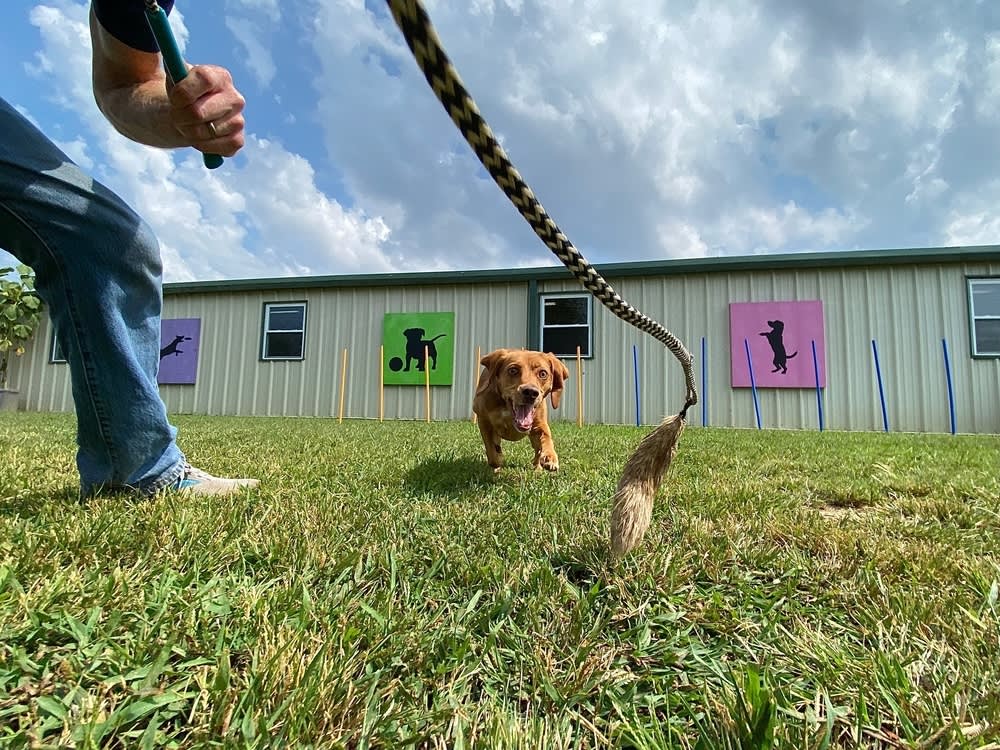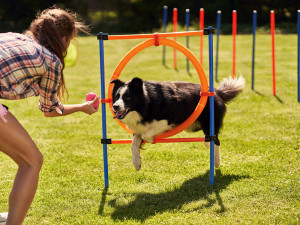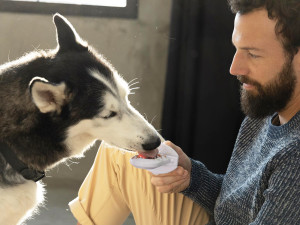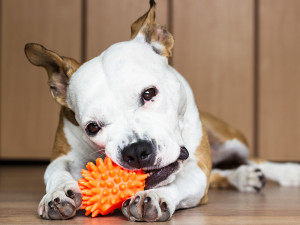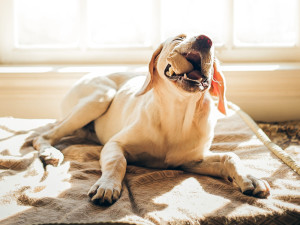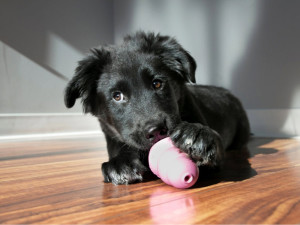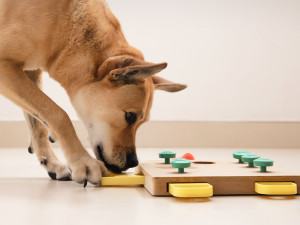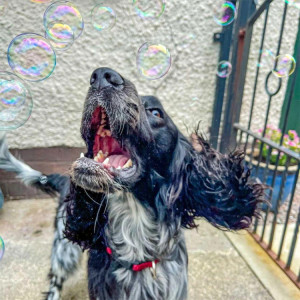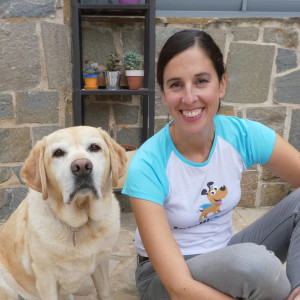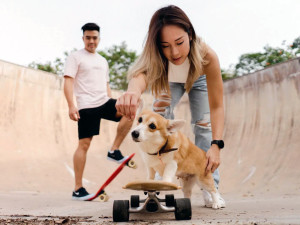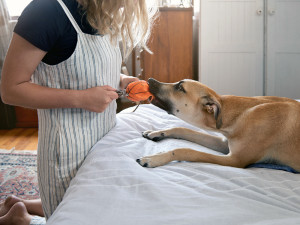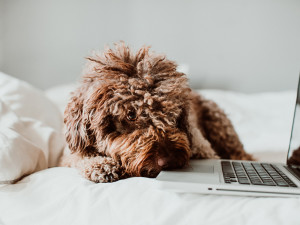Your Dog Is Bored. Here’s How to Solve That
Get out the toys and puzzles
Has your dog ever looked at you and sighed like they have the weight of the world on their shoulders? As we head to work to earn the money that funds their treats and toys, it’s hard not to roll our eyes. What should they, whose biggest problem is choosing the right spot in the living room to chew their bully stick, have to worry about? In truth, your dog probably isn’t complaining about all of life’s burdens; they’re just bored.
Dogs are intelligent, social and emotional beings who, yes, can get easily bored. Providing a pup with a high quality of life depends heavily on enrichment. Enrichment can take many forms: there’s social time with other dogs and other people; tasks that make pups feel important for having a job; sensory enrichment, such as stimulating sight, sound or smell; and nutritional enrichment, which doesn’t mean richer food – it means giving the dog a food-toy that challenges how quickly and easily they can scarf their dinner down.
On the physical enrichment end, it’s important that toys and activities encourage a positive expression of natural behaviours. For example, Terriers love to dig, so an outdoor sandbox will stop them from digging through your carpet. All these aspects of the dog’s environment keep dogs in good physical and psychological condition and keep them from emitting yet another long, drawn-out sigh.
Is my dog bored?
Bored dogs will do things you don’t want them to (does that hole in your favourite cosy couch blanket ring a bell?). Without your constructive direction, dogs will often make up their own amusements that don’t amuse you. Signs that your dog is bored are: barking or biting for attention, getting in the trash, destructive chewing, jumping and lots of other mischiefs. They might also sleep more, sigh or be on alert. Truly, there’s no creature on earth more creative than a frustrated pup.
How to help a bored dog
There are many ways to bring joy into your dog’s day besides feeding them treats and asking, ‘Who’s a good doggo?’ Dogs need so much stimulus because their wild canine ancestors faced puzzles and challenges every day in their search for food, water and shelter. We have all those things covered for our pups, but that brain energy needs to go somewhere. Here are some suggestions for channelling that energy in an appropriate way for the whole household’s sake.
Give your pup plenty of exercise
Like your Peloton instructor has probably told you as you turn the dial to add resistance once again, there’s nothing like exercise to boost serotonin and endorphin production, and a simple dog walk does a lot to increase physical activity and stimulation for your dog. It can also benefit the dog in terms of social interaction, meeting other dogs and friendly people along the way. You might make a friend, too.
Help your dog go on a chase
If you can’t get a long walk in, try a ‘flirt pole’. A flirt pole is a simple tool to help you drag a toy on the ground in a circle to be chased and tugged by the dog. Flirt poles are super easy to DIY at homeopens in new tab. Ten minutes of toy chase with a flirt pole will work out the dog without tiring you, fulfil their natural prey instinct, and work on your dog’s cue response skills. When in a state of high arousal through chasing and tugging, your dog can practise listening to you and cooling off quickly. That means dropping the toy and lying down when you ask them to. Doing this before you go out is a great option because it helps them relax and expel some anxiety.
Keep your pup mentally fit.
Mental enrichment lowers stress levels and keeps dogs from getting bored and starting unwanted behaviours at home. Animate (social interaction) and inanimate (toys, puzzles, scent work) enrichment might even prevent certain behaviours that have already presented from getting worse.
Rotate their toys to keep them engaged
You can keep your dog from getting bored with the help of toys, but it is really important to rotate them. Dogs will lose interest in the same toy after a short period of time – dogs are very similar to kids that way. Start by putting toys away after you play together, and only offer your dog two or three at a time. Leave them around for a couple of days before removing them and replacing them with something else from the toy box. This will keep the dog interested in the novelty of their toy collection.
Play tug of war together
One of the most popular dog games is tug of war, and there are some misconceptions about whether or not the dog should ever ‘win’ the game. Research does not show that dogs become more pushy or aggressive when allowed to play tug and win. But if your dog has already shown a tendency to want to control items by growling or snapping, it is probably not a game to play with them. Some dogs are simply not interested in tugging, and that’s fine, too.
Make food time a game
Scatter your dog’s food in the yard or around the house instead of feeding them from a bowl, encouraging more time eating and exercising natural feeding behaviours. You can help your dog by pointing to the place where the food is hidden. Assuming the dogs don’t have resource-guarding issues, scattering food may also work well in multi-dog households: dogs have shown they are able to communicate information about hidden resources to other dogs.
Music can provide entertainment, too
Music can be used as sensory enrichment. Classical music for companion animals has even been developed because, although the mechanism underlying this effect is not well understood, studies show that classical music reduces stress levels and increases resting and sleeping in dogs.
Auditory stimuli may be enriching, but its use depends on how your dog reacts to it. The sound should not be on all the time because even pets need a break from noise, and volume should be kept low. Most importantly, the sound should be tailored to the needs of your dog as much as possible. Many sounds that are pleasant to humans may be displeasing or distressful to dogs. Most of the time, a selection of gentle classical music, soft pop or call-in radio shows will do the trick of keeping your dog in good company, stimulating their senses and lowering stress levels.
Chew toys are your pup’s friend
In addition to the stimulation that a dog gets from interacting with a toy, chewing releases feel-good chemicals in the brain, which keeps dogs happy, busy, and using up energy. Chewing is a tool that dogs have at their disposal to self-medicate for anxiety, boredom and stress, and can produce a sense of euphoria and calmness.
Toys to keep dogs busy
What toys are best for bored dogs? There are plenty to choose from but choosing toys can be tricky: always select the correct size because an item that is too small can lodge in the dog’s throat or be swallowed. Check for small parts that can be chewed off and become choking hazards or create blockages in the intestines. When introducing a new toy, supervise the dog’s initial interactions and check the toy periodically to make sure it’s still in safe shape. An additional warning: some dogs can become protective of toys and even aggressive. If that happens, reach out to a qualified behaviourist to deal with the situation. So they don’t chew on your belongings, here’s a list of solitary toys that’ll keep your pup entertained:
Chew sticks
Chews, such as pig ears, bully sticks and dental bones. Look for all-natural chews, size the chew to the dog, keep an eye on the dog while they’re chewing, and dispose of the chew when it’s small enough to be swallowed.
Food dispensing balls
Food-dispensing balls are probably the most useful group of toys for solitary play. The dog rolls them around to release food. There are also balls that need to be chewed and manipulated, such as the Starmark Everlasting Treat Ballopens in new tab and the Orka Ballopens in new tab.
Food stuffing toys
Food pyramids and cubes, such as Kong, Busy Buddy Squirrel Dudeopens in new tab and Buster Cubesopens in new tab. During the summer months, freeze a Kong stuffed with wet dog food, pieces of meat floating in stock, or vegetables covered with some water. (A word of advice: make sure you seal the Kong’s openings with some cheese and place it in a freezer bag to keep it separate from other foods in the freezer.) Puppies, who usually need additional entertainment and appropriate direction when it comes to chewing, can be fed their entire meal with these toys.
Puzzles and games
Puzzles from Nina Ottosson and the Aikiou brands are great for your bright and active puppy. If your dog needs encouragement, make the toys more appealing by rubbing something tasty on them, such as peanut butter. When you first introduce your dog to these toys, make it easy for them to obtain the treats, then gradually increase the difficulty so that your dog learns how to work persistently to extract the food. Otherwise, your dog may get frustrated, leading to the opposite of what we intend to do through enrichment and stimulation.
DIY toys
No need to spend zillions on toys – you can make them yourself. Nest different-sized cardboard boxes, with all staples and tape removed, inside each other, then put a treat in the smallest box. Or use a solid cardboard tube with a few holes to turn it into an exciting food dispenser. Try hiding dry food inside toilet paper tubes, egg cartons, cereal boxes, and so forth.
Why do dogs get bored?
When a dog gets tired of a certain repeated activity, that’s called habituation. Research has shown that introducing novel activities will keep them engaged with play. In one of these studies, a bacon-bubble machine and a playhouse resulted in the greatest behaviour changes. These were both new activities for the dogs in the study, but a bubble machine that smells like bacon would be interesting to anyone.
As with anything in this life, too much or too little will not do the trick. Beware of overstimulation. While stimulating your dog mentally and physically is the goal, overstimulation may increase stress levels. Think of a ball-obsessed dog, such as a Border Collie, bringing their favourite toy and dropping it at their person’s feet over and over again with no off-button. Individual preferences and circumstances must be kept in mind. Spend time identifying things that your dog finds motivating or reinforcing, and adjust playtime routines before your dog reaches a frustration level.
